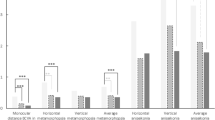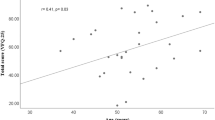Abstract
Background
Participation in first human applications of retinal neuroprosthesis may create psychological stress for blind retinitis pigmentosa patients. The aim of this study was to assess the emotional wellbeing of patients undergoing implantation of a subretinal implant.
Methods
Nine blind patients participating in a pilot trial with subretinal implants were enlisted. The Brief Symptom Inventory (BSI), a short self-report scale of nine primary symptoms, was used to assess reaction to the psychological distress related to study participation. The number and the intensity of symptoms were analysed, and global scores for overall psychological distress (tGSI), severity of reported symptoms (tPDSI), and level number of self-reported symptoms (tPST) were calculated. The questionnaire was administered before implantation, 2–3 times during the trial and before explantation.
Results
There were no significant alterations during the trial for the average scores of the nine primary symptoms. One patient, however, showed values higher than the norm, for six subscores before implantation and for eight subscores before explantation. A significant improvement was found in both the overall psychological distress level (tGSI) and the severity of reported symptoms (tPDSI) at the final visit, compared to those at the study start. The number of self-reported symptoms (tPST) was not significantly altered.
Conclusion
In the first ongoing pilot trial with an active, cable-bound subretinal implant, we found that trial participation and the implant procedure and subsequent testing did not have any adverse effects on the participants’ emotional wellbeing. Their distress generally improved during study participation, rather than showing signs of decreased wellbeing.

Similar content being viewed by others
References
Zrenner E (2002) The subretinal implant: can microphotodiode arrays replace degenerated retinal photoreceptors to restore vision? Ophthalmol 216(Suppl 1):8–20, discussion 52–23
Gekeler F, Sachs H, Szurman P, Messias A, Wilke R, Besch D, Wilhelm B, Zrenner E, Bartz-Schmidt K, Gelisken F (2007) Fluorescein angiographic findings in blind patients treated by an active subretinal implant. Invest Ophthalmol Vis Sci 48:2567
Zrenner E, Wilke R, Zabel T, Sachs H, Bartz-Schmidt K, Gekeler F, Wilhelm B, Greppmaier U, Stett A, SUBRET Study Group (2007) Psychometric analysis of visual sensations mediated by subretinal microelectrode arrays implanted into blind retinitis pigmentosa patients. Invest Ophthalmol Vis Sci 48:659
Besch D, Sachs H, Szurman P, Gulicher D, Wilke R, Reinert S, Zrenner E, Bartz-Schmidt KU, Gekeler F (2008) Extraocular surgery for implantation of an active subretinal visual prosthesis with external connections: feasibility and outcome in seven patients. Br J Ophthalmol 92:1361–1368
Zrenner E, Wilke R, Sachs H, Bartz-Schmidt K, Gekelar F, Besch D et al (2008) Visual sensation mediated by subretinal microelectrode arrays implanted into blind retinitis pigmentosa patients. Biomed Tech 53(Suppl 1):218–220
Stingl K, Greppmaier U, Wilhelm B, Zrenner E (2010) Subretinal visual implants. Klin Monatsbl Augenheilkd 227:940–945
Zrenner E, Bartz-Schmidt KU, Benav H, Besch D, Bruckmann A, Gabel VP, Gekeler F, Greppmaier U, Harscher A, Kibbel S, Koch J, Kusnyerik A, Peters T, Stingl K, Sachs H, Stett A, Szurman P, Wilhelm B, Wilke R (2011) Subretinal electronic chips allow blind patients to read letters and combine them to words. Proc R Soc B 278:1489–1497
Derogatis LR, Melisaratos N (1983) The brief symptom inventory: an introductory report. Psychol Med 13:595–605
Dowling J (2009) Current and future prospects for optoelectronic retinal prostheses. Eye 23:1999–2005
Acknowledgments
We thank the following people for their support in this trial: H. Oelman, C. Kuttenkeuler, R. Wilke and T. Zabel. The authors also thank Anne Kurtenbach for her help in preparing this manuscript. The study was supported by the German Federal Ministry of Education and Research (BMBF: 01KP0401) and the Retinal Implant GmBH, Reutlingen, Germany
Author information
Authors and Affiliations
Corresponding author
Rights and permissions
About this article
Cite this article
Peters, T., Klingberg, S., Zrenner, E. et al. Emotional wellbeing of blind patients in a pilot trial with subretinal implants. Graefes Arch Clin Exp Ophthalmol 251, 1489–1493 (2013). https://doi.org/10.1007/s00417-012-2210-6
Received:
Revised:
Accepted:
Published:
Issue Date:
DOI: https://doi.org/10.1007/s00417-012-2210-6




